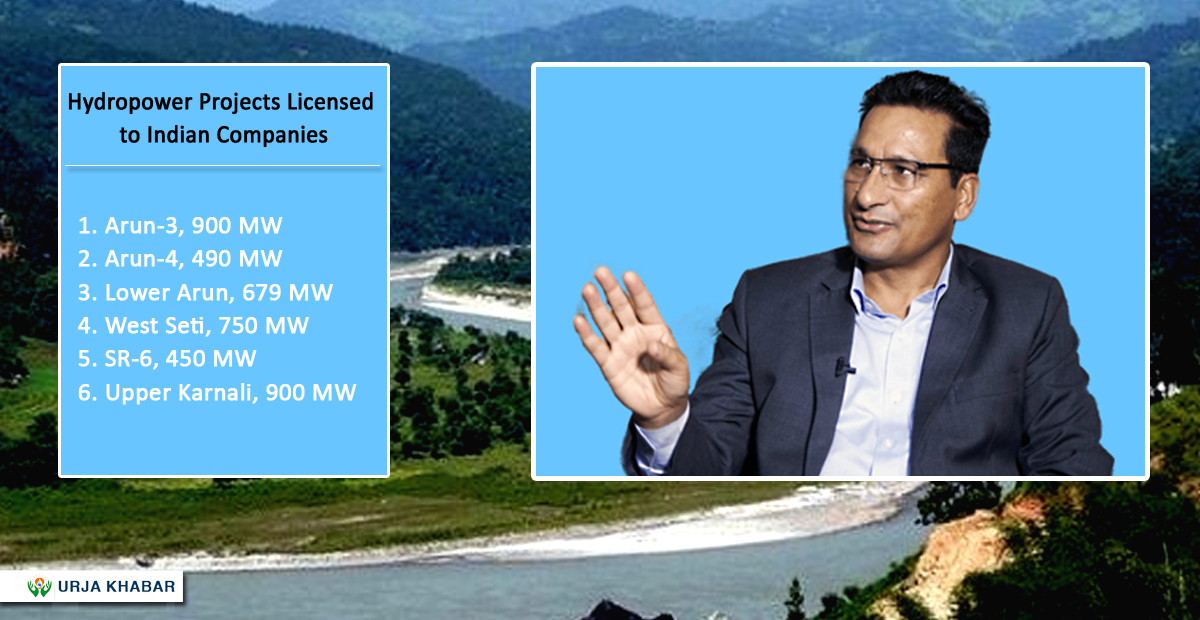
Kathmandu : Minister for Energy, Water Resources and Irrigation Shakti Bahadur Basnet has said the country will build the 1,061 MW Upper Arun Semi-storage Hydropower Project.
At a time when there is much talk that Prime Minister Pushpa Kamal Dahal during his visit to India, will be handling the agreement to an Indian company, Minister Basnet has clarified the government's view.

"It is not unusual that India expresses its interest in Upper Arun, but we have planned to develop this project ourselves," Minister Basnet told Urja Khabar on Thursday.
As of now, Indian company Sutlej Jalvidyut Nigam has received permission for 900 MW Arun-3, 490 MW Arun-4 and 679 MW Lower Arun. More than 50 percent of Arun-3 work has been completed so far.

Nepal Electricity Authority (NEA) has been reiterating that Sutlej, which is showing interest to construct all the projects in the Arun basin, is putting a lot of pressure on the government and the diplomatic level to grab the contract for the Upper Arun. At present, the NEA, through a subsidiary company named Upper Arun Hydro Electric Limited, has started a study on various aspects of the project.
A senior official at the MOEWRI said India will be forwarding the matter as the major issue during the upcoming India visit by Nepali Prime Minister Dahal. It is also said that Dahal’s India visit has been delayed mainly due to this matter.
A study is being carried out on the 454 MW Arun at Kimathanka, which is situated in the high mountain area above Upper Arun, located near the Nepal-China border. While the Chinese side is also showing interest in the construction of this project, some Chinese companies have been lobbying the government to get the construction contract. In this regard, it seems easier to maintain a balance in diplomatic relationships with India and China if Nepal develops the projects including Kimathanka Arun in the upper region and Arun-3 in the lower coast and related projects.
If Nepal is to take geopolitical relations with China and India, diplomacy and hydropower development together, it seems inevitable that the country develop Upper Arun by itself. Otherwise, it is obvious that Nepal will face some sort of difficulty from the viewpoint of the geographical border security of its two neighboring countries.
Discussions are also underway between the World Bank and the Asian Development Bank (ADB), major development partners of Nepal, on the matter of helping the country by gathering foreign investment in the Upper Arun. These two international organizations are reported to have started discussions with the Asian Infrastructure Investment Bank (AIIB) and the European Investment Bank (EIB) to get loans for the project.
Apart from the aforementioned projects, Indian companies have also been granted permits for 900 MW Upper Karnali (GMR Energy Company), 750 MW West Seti Reservoir and 450 MW Seti River-6 (NHPC Limited). Similarly, the MoEWRI source informed that it has consented to hand over the construction of 480 MW Phukot Karnali and 439 MW Betan Karnali to Indian companies.
Mode of investment
The environmental and social impact studies of this project are now almost completed. According to this study, the total cost is estimated at Rs 214 billion. The investment modality of the project, which has been considered under the People's Hydropower Program, will include 30 percent equity and 70 percent loan investment.
Hydro Electricity Investment and Development Company Limited (HIDCL) has undertaken to raise loan investment of Rs 53 billion. For this purpose, a memorandum of understanding has been signed between Upper Arun and HIDCL on September 15, 2022.
There is a provision that while developing projects under the People's Hydropower Program, 41 percent of the capital investment will be from the NEA, and five percent each from the local and provincial governments. Out of the remaining 49 percent, 33 percent will be owned by general people, 10 percent by the project-affected locals and three percent each by the employees of the project developer and the general people affected by the transmission lines.
Phanindra Raj Joshi, managing director of the company, said the equity investment will be finalized based on the stated equity structure. For around Rs 97 billion to be generated from foreign investment, the World Bank has assured to take the lead, according to Joshi. "So far, the hiring process of the main consultant is in the final stage after completing the studies on environmental and social impact assessments,” said Joshi. “The main consultant will also work to simplify processes related to documentation of contract, short-listing, and onsite inspection of the construction works," he said.
The potential benefit of the project
The project that will be producing 4.50 billion units of electricity will install six units, out of which four will be operated throughout the winter season. A study has shown that the project will generate 697 MW of electricity when it is operated for six hours a day during peak demand time during winter.
Even if the authority sells electricity at a minimum of Rs 10 rupees per unit, it seems to generate income of Rs 45 billion per annum. Individuals and agencies concerned have been putting pressure on the government stating that Nepal should build such a project that can provide employment to thousands of people. The project is scheduled to start construction in 2025 and to be completed by 2030.
According to the study, the environmental and social impacts are extremely low as it will displace only 23 households physically, while 335 households will be financially displaced by the project.